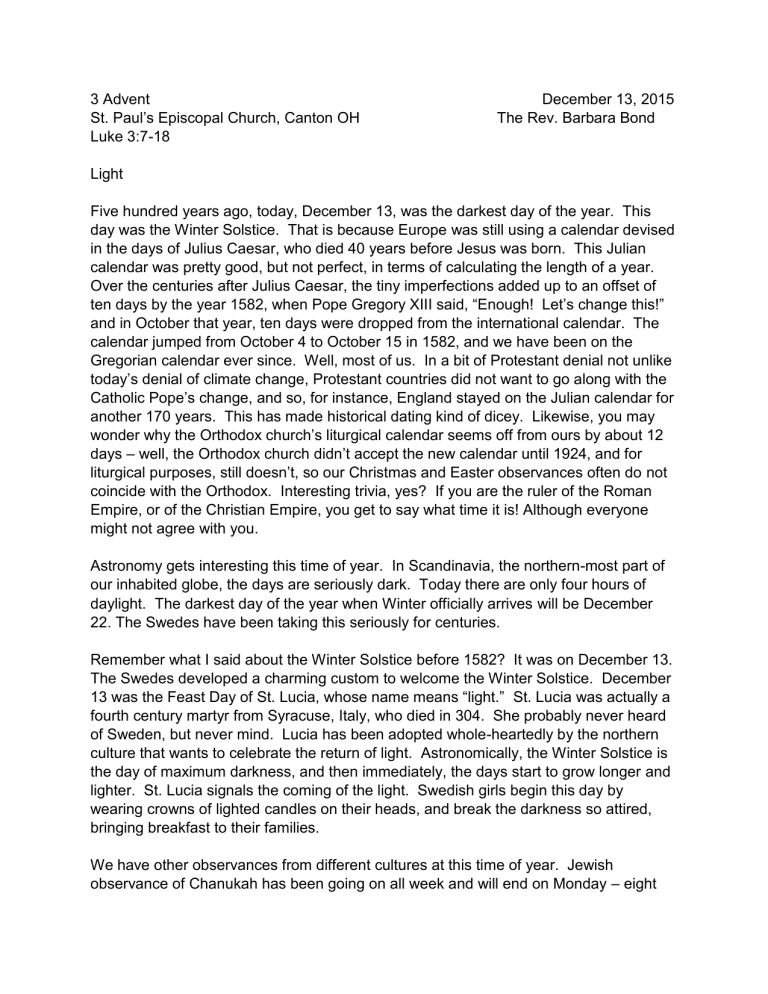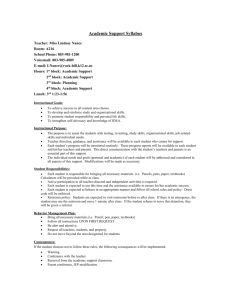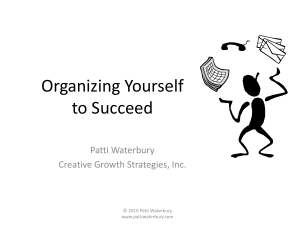File

3 Advent
St. Paul’s Episcopal Church, Canton OH
Luke 3:7-18
Light
December 13, 2015
The Rev. Barbara Bond
Five hundred years ago, today, December 13, was the darkest day of the year. This day was the Winter Solstice. That is because Europe was still using a calendar devised in the days of Julius Caesar, who died 40 years before Jesus was born. This Julian calendar was pretty good, but not perfect, in terms of calculating the length of a year.
Over the centuries after Julius Caesar, the tiny imperfections added up to an offset of ten days by the year 1582, when Pope Gregory XIII said, “Enough! Let’s change this!” and in October that year, ten days were dropped from the international calendar. The calendar jumped from October 4 to October 15 in 1582, and we have been on the
Gregorian calendar ever since. Well, most of us. In a bit of Protestant denial not unlike today’s denial of climate change, Protestant countries did not want to go along with the
Catholic Pope’s change, and so, for instance, England stayed on the Julian calendar for another 170 years. This has made historical dating kind of dicey. Likewise, you may wonder why the Orthodox church’s liturgical calendar seems off from ours by about 12 days – well, the Orthodox church didn’t accept the new calendar until 1924, and for liturgical purposes, still doesn’t, so our Christmas and Easter observances often do not coincide with the Orthodox. Interesting trivia, yes? If you are the ruler of the Roman
Empire, or of the Christian Empire, you get to say what time it is! Although everyone might not agree with you.
Astronomy gets interesting this time of year. In Scandinavia, the northern-most part of our inhabited globe, the days are seriously dark. Today there are only four hours of daylight. The darkest day of the year when Winter officially arrives will be December
22. The Swedes have been taking this seriously for centuries.
Remember what I said about the Winter Solstice before 1582? It was on December 13.
The Swedes developed a charming custom to welcome the Winter Solstice. December
13 was the Feast Day of St. Lucia, whose name means “light.” St. Lucia was actually a fourth century martyr from Syracuse, Italy, who died in 304. She probably never heard of Sweden, but never mind. Lucia has been adopted whole-heartedly by the northern culture that wants to celebrate the return of light. Astronomically, the Winter Solstice is the day of maximum darkness, and then immediately, the days start to grow longer and lighter. St. Lucia signals the coming of the light. Swedish girls begin this day by wearing crowns of lighted candles on their heads, and break the darkness so attired, bringing breakfast to their families.
We have other observances from different cultures at this time of year. Jewish observance of Chanukah has been going on all week and will end on Monday – eight
days of lighting candles on menorahs, to celebrate the miraculous burning of the
Temple menorahs in the year 165 BC. – miraculous because they didn’t have enough oil for even one night, yet the menorahs burned for eight nights. And here is our Advent wreath, up to three lighted candles this week, as we light our way towards Christmas.
So – is all this candle-lighting just charming custom? I don’t think so. The manifestation of the candles is pointing to something more profound.
Yesterday, I listened to a recording of George Friedrich Handel’s Messiah . I was especially struck by the Bass recitative and aria, whose words go like this:
“For behold, darkness shall cover the earth, and gross darkness the people; but the Lord shall arise upon thee, and His glory shall be seen upon thee. And the Gentiles shall come to thy light, and kings to the brightness of thy rising.” (Isaiah 60:2-3). And then the aria: “The people that walked in darkness have seen a great light; and they that dwell in the land of the shadow of death, upon them hath the light shined.” (Isaiah 9:2) Both are verses from Isaiah, and the aria text is our first Lesson on Christmas Eve. These Hebrew texts have been used for centuries by Christians to point to the coming of the Messiah, Jesus the Christ. George Friedrich Handel didn’t make this up! He used traditional texts and their Christian interpretations in his masterpiece oratorio.
Isaiah was a great prophet – actually, he was probably three great prophets, whose writings have been gathered together under the name Isaiah, writing at different times in
Jewish history, and addressing different issues current to their time. He was not predicting the birth of Jesus. A prophet is not in the business for foretelling the future.
Rather, a true prophet “tells it like it is” right now. Another definition of a prophet is “one who speaks truth to power.” The three Isaiahs spoke truth to the courts of Judah, warning that things would change, mostly for the worse, if they didn’t shape up.
John the Baptist has often been called the last of the Old Testament prophets, and as such is a bridge to the New Testament, the time of Jesus. Luke even says that John and Jesus were cousins. John is presented in our Gospel reading today as pretty harsh, speaking truth to the people, and demanding change. Yet the people hear him willingly, and even say, “What then shall we do?” Somehow they know that the way they are living, their attitudes, are pretty shallow, and they want to change.
So – here’s my own favorite image of John the Baptist, not scriptural. A big crowd is bustling through a typical mall, twinkling lights all around, “Jingle Bells” piped through the air, when suddenly the PA system coughs, and another voice is heard by all the shoppers: “You brood of vipers! Who warned you to flee from the wrath to come?”
And all the shoppers stare into the air, thinking, “Who? Me? Brood of vipers?” But they hear the words of the prophet, and ask, “What then shall we do?” And John says, “Give to the poor, change your attitude, and welcome the light that is coming, the true light coming into the world.” And the people say, “Amen.”






